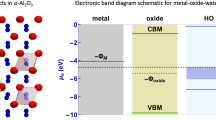Abstract
Using the CASTEP module in Materials Studio software, the native defect model structures including O vacancy and Al vacancy in Al2O3(110) surface were designed and constructed. Through first-principles based on density functional theory (DFT) and pseudo potential method, the Al2O3(110) model structures were optimized. Formation energy, energy state structure, electric density and electron population of defect structures and primitive cell were calculation. Effect of O vacancy and Al vacancy on Al2O3 properties could be analyzed and probed. The results showed that formation energy of O vacancy is only 0.06 eV, which is significantly less than that of Al vacancy (2.99 eV). This indicates that the formation of O vacancy is more easily to produce. O vacancy defects reduce electronic energy in Al2O3(110), and make its conductivity become poorer. The impact of Al vacancy defects on conductivity are opposite. The influence of aluminum vacancy defects on electron density in Al2O3(110) is more than that of oxygen vacancy; oxygen vacancy increases the electronegativity around O atoms, and weakens electropositivity around Al atoms the electricity, which makes the top of energy band structure move down. The calculation results provide a theoretical guidance for the formation of functional anodic oxidation films of Al.



Similar content being viewed by others
REFERENCES
Cui, X., Wu, Y., Liu, X., Zhao, Q., and Zhang, G., Mater. Des., 2015, vol. 86, p. 397.
Armelin, E., Whelan, R., Martínez-Triana, Y.M., Alemán, C., Finn, M.G., and Díaz, D.D., ACS Appl. Mater. Interfaces, 2017, vol. 9. p. 4231.
Saleema, N., Sarkar, D.K., Gallant, D., Paynter, R.W., and Chen, X.G., ACS Appl. Mater. Interfaces, 2011, vol. 3, p. 4775.
Cui, X., Wu, Y., Zhang, G., Liu, Y., and Liu, X., Composites, Part B, 2017, vol. 110, p. 381,
Shin, J.S., Ko, S.H., and Kim, K.T., J. Alloys Compd., 2015, vol. 644, p. 673.
Ji, Y., Wang, F, Gu, Z., and Gong, X., Chemistry, 2014, vol. 77, p. 236.
Ebrahimi, S., Ghafoori-Tabrizi, K., and Rafii-Tabar, H., Comput. Mater. Sci., 2013, vol. 71, p. 172.
Zhang, S., Liu, F., and Cheng, X., J. Yibin Univ., 2011, vol. 11, p. 77.
Wang, Y., Zhang, X., Zhao, L., Zhao, X., Shi, B., and Fan, C., Chem. J. Chin. Univ., 2014, vol. 35, p. 2624.
Du, Y., Chang, B., and Wang, H., Chin. Opt. Lett., 2012, vol. 10, p. 39.
Feng, Q., Wang, X., and Liu, G., J. At. Mol. Phys. (Chengdu, China), 2008, vol. 25, p. 1096.
Ma, X., Jiang, J., and Liang, P., Acta Phys. Sin., 2008, vol. 57, p. 3120.
Liu, B., Ma, Y., and Zhou, Y., Acta Phys. Sin., 2010, vol. 59, p. 3577.
Hine, N.D.M., Frensch, K., Foulkes, W.M.C., and Finnis, M.W., Phys. Rev. B, 2009, vol. 79, p. 1.
Chang, Q., Liu, T., and Ma, C., Sci. China Chem., 2016, vol. 46, p. 394.
**ang, X., Zhang, G., Wang, X., Tang, T., and Shi, Y., Phys. Chem. Chem. Phys., 2015, vol. 17, p. 29134.
Choi, M., Janotti, A., and Van de Walle, C.G., J. Appl. Phys., 2013, vol. 113, p. 044501.
Yang, C., Yu, Y., Li, Y., and Liu, Y., Chin. J. Chem. Phys., 2004, vol. 17, p. 537.
Zhang, W., Xu, Z.P., Wang, H.Y., Chen, F.H., and He, C., Acta Phys. Sin., 2013, vol. 62, p. 243101.
Van de Walle, C.G. and Neugebauer, J., J. Appl. Phys., 2004, vol. 95, p. 3851.
Liu, R., Teng, B.T., Quan, J.L., Lang, J.J., and Luo, M., Acta Phys. -Chim. Sin., 2013, vol. 29, p. 271.
Lou, Z.C., Zhang, G.Y., Liang, T., Li, D., and Zhu, S.L., J. Shenyang Norm. Univ., Nat. Sci. Ed., 2010, vol. 28, p. 189.
FUNDING
This work is financially supported by the Industry-University-Research Cooperation Project of Jiangsu Province in 2018 (no. BY2018276).
Author information
Authors and Affiliations
Corresponding author
Rights and permissions
About this article
Cite this article
Zeng, J., Wu, G., Shi, W. et al. First-Principles Study on Properties of the Native Defects in Al2O3(110) Surface. Prot Met Phys Chem Surf 55, 631–636 (2019). https://doi.org/10.1134/S2070205119040300
Received:
Revised:
Accepted:
Published:
Issue Date:
DOI: https://doi.org/10.1134/S2070205119040300




